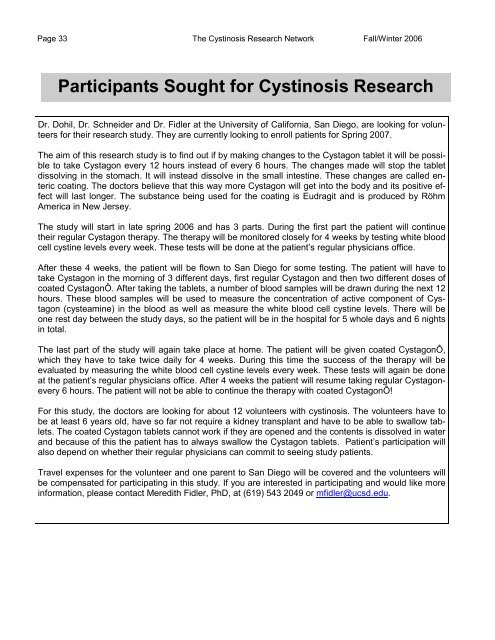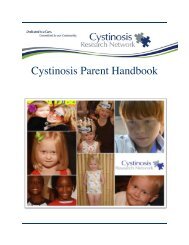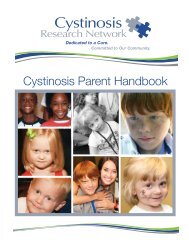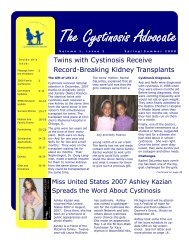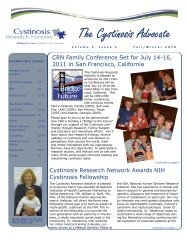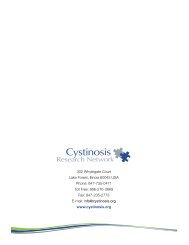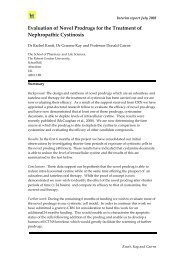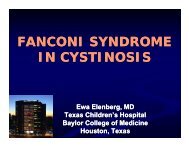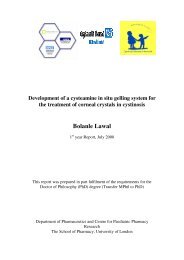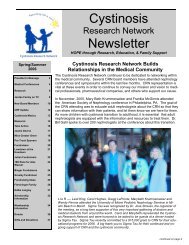Cystinosis Newsletter - Cystinosis Research Network
Cystinosis Newsletter - Cystinosis Research Network
Cystinosis Newsletter - Cystinosis Research Network
Create successful ePaper yourself
Turn your PDF publications into a flip-book with our unique Google optimized e-Paper software.
Page 33 The <strong>Cystinosis</strong> <strong>Research</strong> <strong>Network</strong> Fall/Winter 2006<br />
Participants Sought for <strong>Cystinosis</strong> <strong>Research</strong><br />
Dr. Dohil, Dr. Schneider and Dr. Fidler at the University of California, San Diego, are looking for volunteers<br />
for their research study. They are currently looking to enroll patients for Spring 2007.<br />
The aim of this research study is to find out if by making changes to the Cystagon tablet it will be possible<br />
to take Cystagon every 12 hours instead of every 6 hours. The changes made will stop the tablet<br />
dissolving in the stomach. It will instead dissolve in the small intestine. These changes are called enteric<br />
coating. The doctors believe that this way more Cystagon will get into the body and its positive effect<br />
will last longer. The substance being used for the coating is Eudragit and is produced by Röhm<br />
America in New Jersey.<br />
The study will start in late spring 2006 and has 3 parts. During the first part the patient will continue<br />
their regular Cystagon therapy. The therapy will be monitored closely for 4 weeks by testing white blood<br />
cell cystine levels every week. These tests will be done at the patient’s regular physicians office.<br />
After these 4 weeks, the patient will be flown to San Diego for some testing. The patient will have to<br />
take Cystagon in the morning of 3 different days, first regular Cystagon and then two different doses of<br />
coated CystagonÔ. After taking the tablets, a number of blood samples will be drawn during the next 12<br />
hours. These blood samples will be used to measure the concentration of active component of Cystagon<br />
(cysteamine) in the blood as well as measure the white blood cell cystine levels. There will be<br />
one rest day between the study days, so the patient will be in the hospital for 5 whole days and 6 nights<br />
in total.<br />
The last part of the study will again take place at home. The patient will be given coated CystagonÔ,<br />
which they have to take twice daily for 4 weeks. During this time the success of the therapy will be<br />
evaluated by measuring the white blood cell cystine levels every week. These tests will again be done<br />
at the patient’s regular physicians office. After 4 weeks the patient will resume taking regular Cystagonevery<br />
6 hours. The patient will not be able to continue the therapy with coated CystagonÔ!<br />
For this study, the doctors are looking for about 12 volunteers with cystinosis. The volunteers have to<br />
be at least 6 years old, have so far not require a kidney transplant and have to be able to swallow tablets.<br />
The coated Cystagon tablets cannot work if they are opened and the contents is dissolved in water<br />
and because of this the patient has to always swallow the Cystagon tablets. Patient’s participation will<br />
also depend on whether their regular physicians can commit to seeing study patients.<br />
Travel expenses for the volunteer and one parent to San Diego will be covered and the volunteers will<br />
be compensated for participating in this study. If you are interested in participating and would like more<br />
information, please contact Meredith Fidler, PhD, at (619) 543 2049 or mfidler@ucsd.edu.


